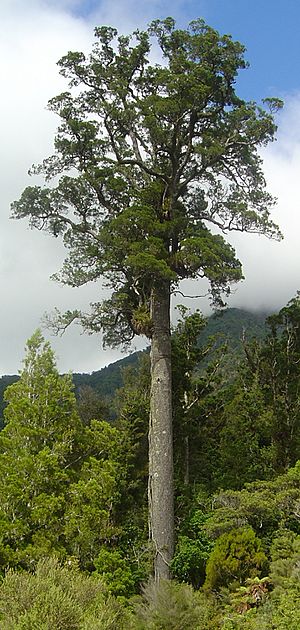Kahikatea facts for kids
Quick facts for kids Kahikatea |
|
|---|---|
 |
|
| Mature kahikatea tree | |
| Conservation status | |
| Scientific classification | |
| Genus: |
Dacrycarpus
|
| Species: |
dacrydioides
|
 |
|
| Natural range of D. dacrydioides | |
| Synonyms | |
|
|
The kahikatea (from its Māori name) is a tall conifer tree found only in New Zealand. Its scientific name is Dacrycarpus dacrydioides. These amazing trees can grow very tall and live for hundreds of years!
Contents
What is a Kahikatea Tree Like?
Kahikatea trees can grow up to 55 metres (180 ft) (about 180 feet) tall. Their trunks can be more than 1 metre (3 ft) (3 feet) wide. The bottom of the trunk often has strong, wide supports called buttresses. These help the tree stand firm.
The leaves of the kahikatea change as the tree grows. Young trees have leaves that are like small needles, about 3 to 8 mm long. They lie flat along the branches. Older trees have smaller, scale-like leaves, only 1 to 3 mm long. These leaves grow all around the branch.
Kahikatea Cones and Seeds
Kahikatea trees produce special cones. These cones are different from the hard, woody cones you might see on a pine tree. When they are ripe, the cone scales become soft and fleshy. They turn a bright orange or red color. Each cone has a single seed on top, about 3 to 5 mm wide.
Birds love to eat the colorful, fleshy part of the cones. When they eat them, they help spread the seeds. The seeds pass through the birds' droppings, which helps new kahikatea trees grow in different places. This is how the tree reproduces and spreads its seeds naturally.
Where Do Kahikatea Trees Grow?
Kahikatea trees are common in lowland forests and wet areas across New Zealand. You can find them on both the North Island and the South Island. They can live for at least 600 years, which is a very long time!
Before lots of trees were cut down, some kahikatea trees were known to be even taller, reaching up to 80 meters (262 feet). Today, the tallest known kahikatea is about 56.4 metres (185 ft) (185 feet) tall. It grows near the Matirangi Forest in Taranaki.
Why is it Called Kahikatea?
In the past, some people called this tree "white pine." However, it's not a true pine tree. The name "kahikatea" comes from the Māori language and is now used much more often. Other Māori names for the tree include kaikatea, kahika, katea, kōaka, and koroī.
Uses of Kahikatea Wood
Early European settlers didn't value kahikatea wood as much as other New Zealand timbers like totara. This was because it wasn't as strong or resistant to rot. However, kahikatea wood has some special qualities. It doesn't have a strong smell, and it's clean and lightweight.
Because of these qualities, kahikatea wood became very important for making boxes. In the 1880s, when New Zealand started exporting butter, kahikatea boxes were perfect for shipping the butter overseas. As the butter export business grew, so did the demand for kahikatea wood. Sadly, this meant that many large kahikatea forests, especially in wetlands, were cut down. Today, only small patches of these old forests remain.
Kahikatea wood was also used to build boats until the 1970s. Its long, straight pieces were great for boat construction. It is also lighter than Kauri wood when dry. Even in the 1980s, Māori people used kahikatea to carve waka, which are traditional canoes. They used these canoes for water sports in places like the Kaituna Wetlands.
Traditional Māori Uses
For Māori, the kahikatea tree had many important uses:
- The fleshy, orange koroi (the part of the cone that birds eat) was a valuable food. It was often served in large amounts at feasts.
- The wood was good for making bird spears.
- Soot from burning the heartwood (the inner part of the tree) was used as a dark pigment. This pigment was used for traditional tattooing, known as tā moko.
Protecting Kahikatea Forests
Today, kahikatea trees in private forests can only be harvested if a special permit is given. This permit makes sure that the trees are cut down in a way that allows the forest to grow back sustainably. There are still a few small parts of old kahikatea forests left in places like the Waikato region.
Most kahikatea forests in the Waikato lowlands are relatively young. They are about 80 to 100 years old. These forests grew up around a few very old kahikatea trees that were left standing when most of the original forest was cleared for farming. Some of these old "seed trees" are huge, with trunks over 2 meters (6.5 feet) wide. They are about 400 to 500 years old!
There are about 370 small kahikatea forest areas in the Waikato region. Most of them are quite small, usually between 0.5 and 50 hectares (1.2 to 123 acres). Half of them are even smaller than 5 hectares. They often grow on the floodplains of rivers.
It's not likely that many new large kahikatea forests will grow naturally in the Waikato region today. This is because humans now control floods and replant grass in areas that used to be wet forests. Scientists believe that more than 98% of the original kahikatea forests across New Zealand have been lost since people arrived.
Images for kids
See also
 In Spanish: Kahikatea para niños
In Spanish: Kahikatea para niños









